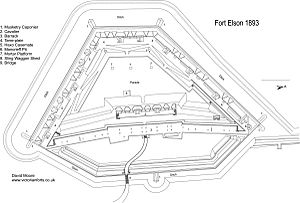Fort Elson facts for kids
Quick facts for kids Fort Elson |
|
|---|---|
| Lua error in Module:Location_map at line 420: attempt to index field 'wikibase' (a nil value). | |
| Type | Palmerston Fort |
| Location | Gosport |
| OS grid reference | SU 59902 02893 |
| Area | Hampshire |
| Built | 1855–1860 |
| Architect | William Crossman |
| Owner | Ministry of Defence |
| Official name: Fort Elson, Gosport | |
| Reference no. | 1001841 |
Fort Elson is an old military fort located in Gosport, England. It was one of the first forts built as part of a large defense plan. These forts are often called Palmerston Forts. Fort Elson was the most northern fort in a line of five. This line of forts was built to protect the area west of Gosport.
The line of forts included Fort Gomer, Fort Grange, Fort Rowner, Fort Brockhurst, and Fort Elson. Building work on Fort Elson started in 1855. It was an important part of the defense system for Portsmouth Harbour.
Contents
Building Fort Elson
Work on Fort Elson began in 1855 and finished in 1860. The fort was already being built when a special group, the Royal Commission on the Defence of the United Kingdom, made plans for more forts. They decided to include Fort Elson in their new defense line. This line was called the 'Gosport Advanced Line'.
The fort was built using a special method. Workers built brick arches, like those you see under a railway bridge. Then, they poured earth on top of these arches. This method was quite tricky. At one point, a large part of the fort's outer wall slipped into the ditch during the night.
How Fort Elson Was Designed
Fort Elson has a D-shaped outer wall where the main guns were placed. The back part of the fort was closed off by a building where soldiers lived. A wet ditch surrounded the fort. It was hard to keep water in half of this ditch. So, a special gate, called a sluice, was built to connect it to Fareham Creek.
The front of the fort had two long sides. Earth ramps led up these sides. This allowed large guns to be moved into position easily. The main storage area for ammunition was hidden beneath the front corner of the fort. You could reach it through a tunnel from the central parade ground.
The soldiers' building had rooms for officers and over 300 other soldiers. There were also stables for two horses. In front of this building, there was another raised area called a cavalier. This area once held more guns. However, these guns were removed in 1892.
To get into the fort, you had to cross a drawbridge over the ditch. Then, you went through a tunnel in the middle of the soldiers' building. Finally, another tunnel led you to the main parade ground inside the fort. More rooms for soldiers were located under the northern side of the fort.
Fort Elson's Weapons
When it was first built, Fort Elson had many different types of guns. These included large 10-inch and 8-inch smooth-bore guns. By 1886, the fort's weapons were updated. It then had eighteen 7-inch R.B.L. guns. These were rifled breech-loading guns, which were more modern. Three large 13-inch mortars were also placed on the parade ground.
Later, there were plans to add even more modern guns. These included 4-inch B.L. guns and 40-pounder R.B.L. guns. By 1891, the fort had eleven 7-inch R.B.L. guns on sliding carriages. It also had three 7-inch R.B.L. guns on special disappearing mounts. These mounts could lower the gun out of sight after firing. Two machine guns were also added. By 1900, it was decided to remove all the weapons. By 1901, Fort Elson was no longer needed for defense.
What Fort Elson Was Used For
During its active years, different army groups looked after the fort's weapons. The main headquarters for all the Gosport Forts was at Fort Rowner. The Royal Artillery Militia also used Fort Elson for their yearly training.
In 1917, Fort Elson got a new job. An early anti-aircraft gun was placed there. This gun was mounted on a lorry. During the Second World War, the fort's underground storage areas were used. They stored special weapons like depth charges and torpedoes.
Fort Elson Today
Today, Fort Elson is still part of a military area in Gosport. This means that the public cannot visit it. The fort is in a very poor condition. It is unlikely to be repaired or restored. This is because of a policy called 'Controlled Ruination'. Fort Elson is a protected historical site. It is also on a list of 'Buildings At Risk' in England.


